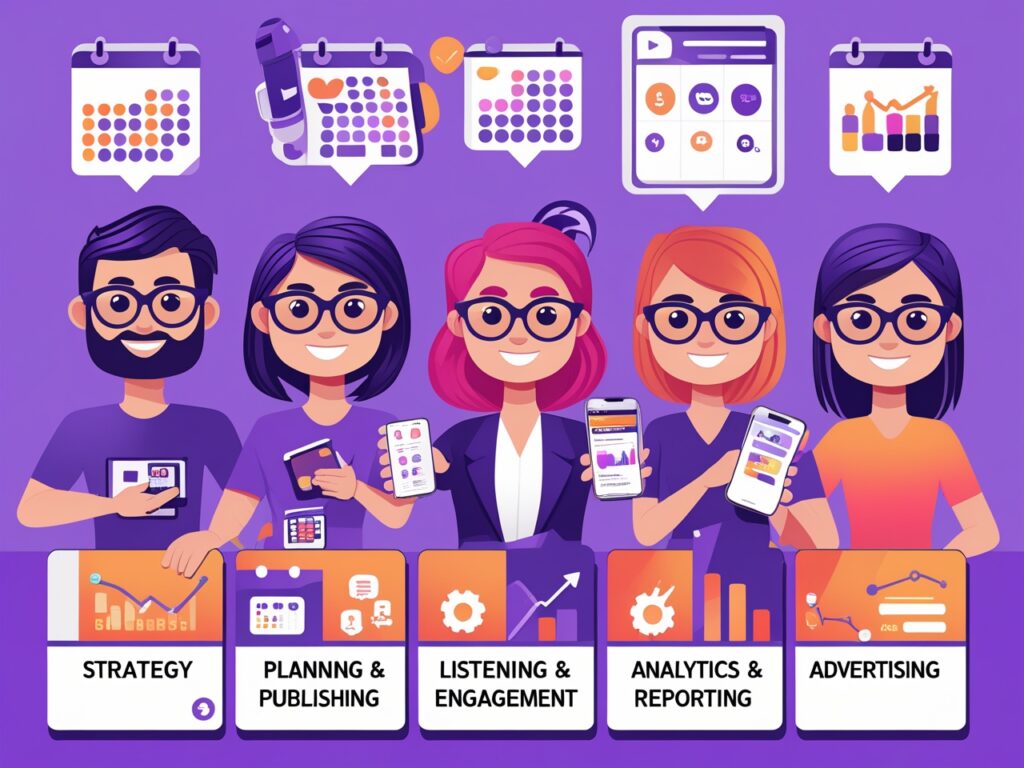
In today’s digital age, social media has revolutionized the way businesses connect with their audiences. From enhancing brand visibility to driving sales, social media platforms offer unparalleled opportunities for growth. However, to harness its full potential, it’s essential to understand and implement the five foundational pillars of social media marketing.
At GCC Technologies, we specialize in transforming clear visions into measurable marketing results. Guided by our core pillars-Growth, Conversions, and Communication-we empower businesses of all sizes with data-driven strategies that build long-term brand value. Whether you’re a startup or a scaling enterprise, our end-to-end marketing solutions are tailored to connect you with your audience and drive real impact.
1. Strategy: Laying the Foundation
A well-defined strategy is the cornerstone of any successful social media campaign. It involves setting clear objectives, understanding your target audience, and selecting the appropriate platforms to reach them effectively.
Key Components:
- Define Clear Objectives: Determine what you aim to achieve-be it brand awareness, lead generation, community engagement, or customer support.
- Identify Target Audience: Understand the demographics, preferences, and behaviors of your ideal customers.
- Select Appropriate Platforms: Choose platforms where your target audience is most active, such as Facebook, Instagram, LinkedIn, or Twitter.
- Set SMART Goals: Ensure your goals are Specific, Measurable, Achievable, Relevant, and Time-bound to guide your content and engagement efforts.
A strategic approach ensures that every action taken on social media aligns with your overall business objectives, maximizing ROI.
2. Planning & Publishing: Consistency is Key
Consistency in content creation and publishing is vital to maintain audience engagement and build trust. Planning ensures that your content aligns with your brand’s voice and resonates with your audience.
Best Practices:
- Develop a Content Calendar: Plan your posts in advance to maintain a consistent posting schedule.
- Tailor Content to Each Platform: Customize your content to fit the unique format and audience expectations of each platform.
- Utilize Scheduling Tools: Use tools like Hootsuite or Buffer to schedule and manage your posts efficiently.
- Incorporate Diverse Content Types: Mix educational, entertaining, promotional, and interactive content to keep your audience engaged.
Effective planning and publishing not only streamline your workflow but also enhance your brand’s online presence.
3. Listening & Engagement: Building Relationships
Social media is a two-way street. Actively listening to your audience and engaging with them fosters community and builds trust.
Actionable Steps:
- Monitor Mentions and Comments: Keep an eye on what people are saying about your brand and respond promptly.
- Engage in Relevant Conversations: Participate in discussions related to your industry to increase visibility.
- Gather Feedback: Use audience feedback to inform future content and strategy adjustments.
- Foster Community: Encourage user-generated content and create spaces for your audience to interact with each other.
Engagement humanizes your brand, making it more relatable and trustworthy to your audience.
4. Analytics & Reporting: Measuring Success
Analyzing your social media performance is crucial to understand what’s working and what needs improvement. Data-driven insights enable you to make informed decisions and optimize your strategy.
Key Metrics to Track:
- Engagement Rates: Monitor likes, shares, comments, and overall interaction with your content.
- Follower Growth: Track the increase or decrease in your follower count over time.
- Conversion Metrics: Measure how many social media interactions lead to desired actions, such as website visits or purchases.
- Content Performance: Assess which types of content resonate most with your audience.
Regularly reviewing these metrics helps in refining your approach and achieving better results.
5. Paid Social Media: Amplifying Reach
While organic reach is valuable, paid social media advertising can significantly amplify your message and target specific demographics. Investing in paid campaigns ensures that your content reaches a broader and more targeted audience.
Strategies for Effective Paid Advertising:
- Define Campaign Objectives: Clearly outline what you want to achieve with your paid ads.
- Target Specific Demographics: Use platform tools to reach your ideal audience based on location, interests, and behaviors.
- Design Compelling Creatives: Create visually appealing and engaging ad content that aligns with your brand.
- Monitor and Optimize: Continuously track ad performance and make necessary adjustments to improve ROI.
Paid social media is a powerful tool to boost visibility, drive traffic, and increase conversions.
Conclusion
Understanding and implementing the five pillars of social media-Strategy, Planning & Publishing, Listening & Engagement, Analytics & Reporting, and Paid Social Media-are essential for building a robust online presence. Each pillar plays a critical role in ensuring that your social media efforts are effective, cohesive, and aligned with your business goals.
At GCC Technologies, we specialize in providing comprehensive social media marketing services tailored to your unique needs. Whether you’re seeking a real estate social media consultant, a social media ad agency, or social media management in Dubai or Abu Dhabi, our team is equipped to deliver results that matter.
Frequently Asked Questions
1. What are the five pillars of social media marketing?
The five pillars are Strategy, Planning & Publishing, Listening & Engagement, Analytics & Reporting, and Paid Social Media. Together, they form a comprehensive framework for effective social media marketing.
2. How does paid social media differ from organic social media?
Organic social media involves free content sharing and audience engagement, while paid social media uses advertising to reach a broader or more targeted audience. Paid strategies can amplify your reach and drive specific actions more effectively.
3. Why is social media analytics important?
Analytics provide insights into your social media performance, helping you understand what works and what doesn’t. This data-driven approach allows for informed decision-making and strategy optimization.
Ready to elevate your social media presence? Contact GCC Technologies today to discover how our expert team can help you achieve your marketing goals.












